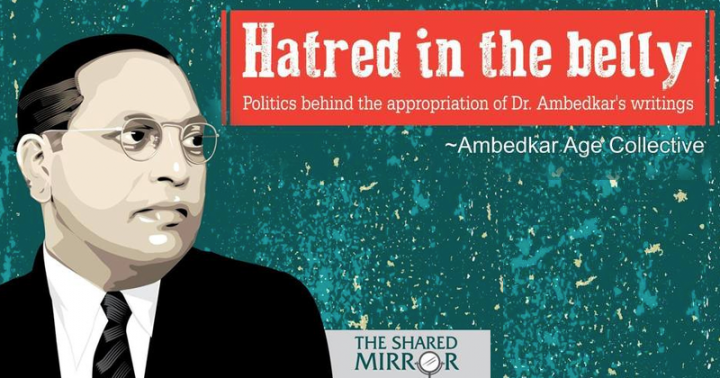Book: Hatred in the Belly
Author(s): Ambedkar Age Collective
Publisher: The Shared Mirror
Genre: Non-fiction
The book Hatred in the Belly may seem like a personal critique of Arundhati Roy for her introduction (“The Doctor and the Saint”) to B R Ambedkar’s seminal text, Annihilation of Caste. But it isn’t. It is actually a critique of domination of upper castes in Indian scholarship, their caste blindness and their refusal to engage with the issues of representation. By extension this book is a critique of Brahminism itself.
Navayana, a self-proclaimed anti-caste publishing house run by S Anand, published an annotated edition of Annihilation of Caste in 2015 with much fanfare. Arundhati Roy’s book-length introduction which castigates M K Gandhi for his racist and casteist views was the main attraction. When the excerpts from the introduction were published in the magazines Outlook and Caravan, Roy had expected a backlash from Gandhians and right-wing nationalists. But the criticism came from an unexpected quarter—the Ambedkarites. Most of this criticism was published on the website Round Table India, an independent media outlet analysing society from caste lens, and the social media profiles of anti-caste activists. Hatred in the Belly is a collection of such critical essays, viewpoints, speeches and interviews.
The major theme that runs in the book is that of representation and appropriation. The book takes Navayana to task for not recruiting a Dalit scholar or an Ambedkarite to introduce an important text like Annihilation of Caste. The publishing house instead approached someone like Roy who had no previous engagement with either caste or Ambedkar. Roy’s privileged status as a Savarna Hindu and Syrian Christian, her larger than life persona, her superficial engagement with various movements in India also come under scrutiny in the book. She is accused of appropriating a text which is central to anti-caste struggles all over the country, a text which was translated by anti-caste volunteers in many Indian languages and published and distributed at personal costs. Roy doesn’t take the pains to engage with this illustrious history of Annihilation of Caste‘s journey since its first publication in 1936, nor does she engage with the contents of the book beyond one paragraph. Instead, most of her introduction is an engagement with Gandhi’s writings. Also, her introduction is almost three times longer than the main text!
When the Hindu reformist group Jat Pat Todak Mandal took objection to Ambedkar’s speech and asked him to alter its contents before he could deliver it as presidential address at their event, Ambedkar refused to do so (saying he “would not change a comma”); it resulted in Ambedkar’s invitation being withdrawn. Ambedkar then published the speech as a booklet and distributed it himself. A number of editions of the book are available since then at cheap rates in various Indian languages; the electronic copy of the book is available for free on the website of Columbia University. Against this backdrop, Navayana’s annotated edition seems like a commercial project catering mainly to Savarna and western readership.
Navayana calls itself “India’s first and only publishing house to focus on the issue of caste from an anti-caste perspective.” But James Michael and Akshay Pathak make an astounding revelation about Navayana.
Out of the list of 61 authors published by Navayana and put up on its website, we could positively identify 37 authors as belonging to privileged communities—this includes 16 Whites and 21 upper castes [of which, 16 were Brahmins] (p 161).
Karthick RM makes it clear why this is deeply problematic.
In contemporary India, take the Indian nationalists, the central committees of the various socialist parties, postcolonialists, liberals, anti-modernists, anti-Eurocentrists, anti-Enlightenmentalists, anti-Colonialists, feminists–which caste defines the ideological paradigms in any of these different political/intellectual groups?
And further asks,
When the Brahmin determines what the philosophy of oppression is, the Brahmin determines what ‘neutral’ liberalism is, and the Brahmin also determines what resistance is, where is the space to counter ideology to emerge (p 188)?
The lack of diversity in Indian scholarship requires an honest introspection. Hatred in the Belly opens the space for a discussion around this issue, and it needs to be taken forward. There is a tendency in Indian academia and media to brush off marginalised voices questioning entrenched privileges as rants, angry outbursts or intellectual bullying. It will be in everybody’s interest if we avoid taking such prejudicial view and resorting to hasty dismissal of criticism. Hatred in the Belly is an important intervention which should be a necessary reading for anyone engaging with issues of social justice from a position of privilege. It will help scholars eschew from indulging in paternalism or, worse, epistemic violence. Navayana’s annotated edition of Annihilation of Caste should serve as a cautionary tale.
Also read: Not a Review but a Request: Read This Book — Hatred in the Belly
Disclaimer: This review was originally published on the author’s blog here.
Featured Image Credit: Cover image of the book Hatred in the Belly




